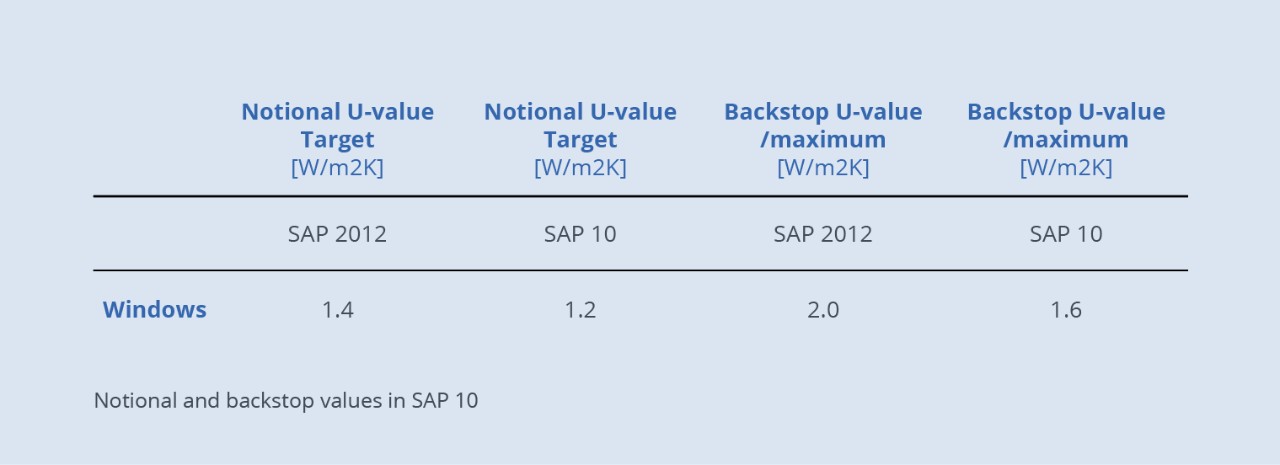A window on the future – changes to Part L Building Regs
An interview with Liam Williamson, Marketing Segment Manager at Guardian Glass
United Kingdom | March 15, 2022The long-awaited changes to the UK Building Regulations were finally published in December 2021 and will come into force on 15th June 2022. These changes focus on greater fabric performance and reduced energy demand, with the ultimate aim of cutting carbon emissions from new homes by around 30%.
One of the five new Approved Documents, Part L (‘Conservation of Fuel and Power’), will have a significant impact on glass and glazing products, particularly for new dwellings. This article will discuss the changes to Part L and how these will affect the UK glass industry, including their impact on glazing products for new dwellings.
What has changed?
The 2021 edition of Approved Document L, Volume 1, introduces new minimum efficiency standards (backstop values) for both new and replacement thermal elements, windows and doors. New build schemes will be assessed under the new SAP 10 (Standard Assessment Procedure) method. Most types of new window, including roof windows and glazed doors, must now achieve an improved U-value of 1.6 W/m2K compared to 2.0 W/m2K previously. However, the U-value of the glass will have to be much lower than this to enable a new dwelling to achieve its targets for primary energy, carbon emissions and fabric energy efficiency rates.

The changes to Part L concern both new and existing dwellings. For existing dwellings, nothing has really changed in terms of the glazing requirements. The previous Part L document and the new version both allow housebuilders to use the same glass to achieve building regulations for existing homes. For example, Guardian ClimaGuard A+ thermal insulating glass was applicable to the previous Part L regulations for ‘existing dwellings’ and can still now be used to meet the new Part L regulations for existing dwellings.
As for new dwellings, the U-value for glazing has been tightened to a notional target of 1.2 [W/m2K], compared to 1.4 in the previous edition. This means glass manufacturers need to provide products that have a Ug-value of 1.0 in order to meet the new regulations. This is because the complete window system including its frame, sealant and spacer bar must be considered when calculating the U-value. In order to achieve a notional UW-value of 1.2, housebuilders and architects will need to specify glass products with a Ug-value of 1.0 W/m2K.
How does this affect the UK glass industry?
What’s particularly interesting here is the impact these changes will have on the type of glass products housebuilders can use and which glass products glass processors and window makers will choose to stock.
In the previous Part L edition, a glass product with a 1.2 Ug-value could be used for windows in both new and existing dwellings. However, with the new Part L regulations, glass processors will now need to consider having either two type of Ug-value product in their offer – 1.2 and 1.0 W/m2K, or choosing only 1.0 Ug-value product that can cover both existing builds and new builds as well.
High level energy performance with improved aesthetics
In order to achieve a Ug-value of 1.0 W/m2K, Guardian Glass has taken a very different approach, believing that the glass should help bring as much natural daylight as possible into people’s homes, with clearer, less reflective view. Thanks to Guardian knowledge in coated glass innovation ClimaGuard® Neutral 1.0 is more colour-neutral with a lower reflection.
ClimaGuard® Neutral 1.0 achieves 74% light transmission for a double IGU 4-16-4 panel (coating on surface #3, 90% argon fill), 14% light reflection and a solar factor of 52%.
What about heat treatment and stocking?
Guardian ClimaGuard Neutral 1.0 will be supplied annealed as standard to the glass processor, who can then heat treat the glass for safety applications if needed. In both cases the product meets the 1.0 Ug-value requirement. This means glass processors don’t need to stock two different glass products (a heat treatable version and an annealed version) to meet the demand from window makers.
Is triple glazing the future?
The changes to Part L aim to fill the void before the UK Government’s ‘Future Homes Standard’ comes into play in 2025. One of the aims of Part L over the last few years has been to try to push the building industry towards the use of triple glazing. In the UK, only 2-3% of builds utilise triple glazing. The UK climate doesn’t really require triple glazing everywhere as we are not subjected to extremes of hot and cold.
Currently the U-values for windows are 1.4 and 1.2 W/m2K. If the Building Regulations are moved down to 1.0 or below, double glazing would no longer be able to meet these tighter regulations. A move towards increased use of triple glazing is therefore inevitable. We know the industry and regulations are moving towards more energy efficient buildings and so triple glazing will have a key role to play here. We obviously need to wait for 2025 to see what happens to the regulations but rest assured that Guardian Glass will work with glass processors to develop the best possible economical solution to meet the applicable requirements.
If you have any questions about the new Part L Building Regulations and how these affect glass and glazing products, please contact your local Guardian Glass expert.

About the Expert - Liam Williamson
Based in the UK, Liam has been working for Guardian for more than eight years in different roles, as Regional Marketing Manager for UK and Ireland for four years and most recently as Marketing Segment Manager for Europe. In his role, Liam participates in regulatory working groups at the Glass and Glazing Federation and at British Glass, promoting the use of glass in the UK building sector.